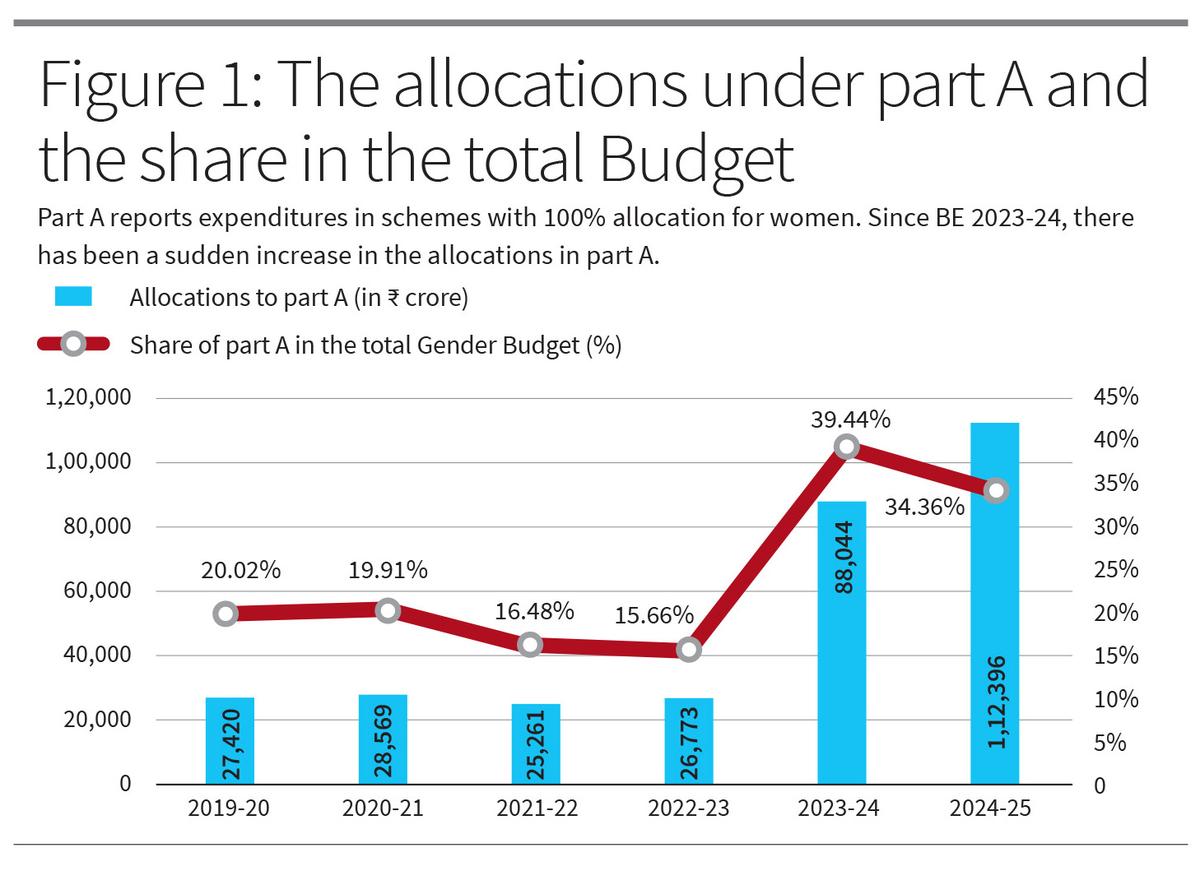Labourers aided by the Mahatma Gandhi Nationwide Rural Employment Assure Act (MGNREGA), work at a building web site on the outskirts of Amritsar on July 23.
| Photograph Credit score: AFP
The story up to now: Girls-led improvement stays on the core of announcements made by the Finance Minister (FM) in this year’s Budget. This dedication to ladies empowerment was mirrored in Price range allocations to pro-women programmes, as reported by the Gender Price range Assertion (GBS). The GB reached 1% of GDP estimates in 2024-25 for the primary time, and total allocations at present stand at greater than ₹3 lakh crore for pro-women programmes.
What’s the cause for the rise?
The GBS, because it was first launched in 2005-06, persistently reported a mean share of 5% of the full budgetary allocations, with marginal ups and downs. This yr is particular because the share of allocations to pro-women schemes stands at roughly 6.8% of the full finances expenditure for 2024-25, which is method above the same old tendencies and marks a constructive departure from established order.
The rise in GB allocations are pushed by two elements. Part of this enhance has been on account of the newly included Half ‘C,’ a 3rd half within the GBS that experiences pro-women schemes with lower than 30% provisioning for ladies. The PM Kisan scheme within the agriculture sector has been reported partially C with an outlay of ₹15,000 crore. That is 25% of the full outlay of the programme. The second issue driving the general enhance is the increment partially A of the GBS. Half A experiences expenditures in schemes with 100% allocation for ladies.
Half A had beforehand constituted 15-17% of total allocations reported within the GBS until BE 2022-23. Since BE 2023-24, there was a sudden enhance within the allocations partially A that raised the share of pro-women schemes with 100% allocations for ladies to virtually 40% (determine 1).

This was primarily because of a change within the reporting the place the Pradhan Mantri Awas Yojana (PMAY) — rural and concrete — began getting mirrored partially A as a substitute of half B. Half B of the GBS experiences programmes with allocations of 30-99% for ladies. Therefore, solely part of PMAY was reported earlier. Starting final yr, the whole allocation of ₹80,670 crore in PMAY for 2024-25BE has been reported underneath half A thus driving the up allocations. Such reporting of PMAY is probably not fully correct as not all beneficiaries are ladies.
Have there been different cases of over-reporting/under-reporting?
Over-reporting may be present in different cases such because the PM Employment Technology Programme (PMEGP), which goals to help entrepreneurs in organising micro companies within the non-farm sector. The GBS reported an allocation of ₹920 crore or 40% of the full allocation to PMEGP, with out offering any clarification for such reporting.
Alternatively, lacking allocations typically deflate the quantity spent by programmes on ladies’s wants. For instance, this yr for the primary time the whole allocation to the Nationwide Rural Livelihoods Mission (NRLM) is mirrored partially A of the GBS, indicating that 100% of its outlay is devoted to ladies and ladies, which is technically appropriate and may have been carried out earlier. In 2023-24BE, solely 50% of the scheme’s complete outlay was once mirrored partially B of the GBS. The GBS this yr has additionally accurately reported elevated allocations for the Ministry of Electronics & IT. Nevertheless it missed out reporting pro-women allocations within the schemes for ladies entrepreneurs equivalent to PM Vishwakarma, SVANidhi, and Stand-Up India.
In one other occasion, the Mahatma Gandhi Nationwide Rural Employment Assure Scheme (MGNREGS), which has the third highest allocation amongst schemes for ladies within the GBS, is at present reported underneath half B with ₹28,888.67 crore which is 33.6% of its complete outlay. It is very important be aware that girls constituted 59.3% of all individual days underneath MGNREGA as of December 2023, and may have obtained commensurate wages from the full MGNREGA finances, but solely 33.6% will get mirrored within the GBS.
What subsequent?
These anomalies might be minimised by incorporating explanations for the entries made within the GBS. Incorporating explanations for allocations in GBS wouldn’t solely guarantee accounting accuracy however will assist in gender audits and supply pathways for improved gender outcomes in authorities programmes. A number of years of advocating for improved reporting within the GBS by consultants is mirrored within the inclusion of a 3rd half. The above anomalies in reporting are reflections of the GBS nonetheless not having a scientific and systematic method.
Efforts to cut back misreporting and enhance the standard of the GBS is obvious, however there’s nonetheless a protracted method to go. The necessity for together with rationale can also be to keep up that detailed reporting shouldn’t be a mere train in rising the quantum of allocations reported for ladies’s improvement — it’s to make sure precise spending for ladies in all authorities programmes, which might be properly deliberate and designed to incorporate ladies’s wants from its inception. Gender responsive budgeting is a robust instrument to shut the gender gaps in an financial system.
Sona Mitra and Sruthi Kutty work with IWWAGE, an initiative of LEAD at Krea College, and Sonakshi Chaudhry works at The Quantum Hub (TQH Consulting).



